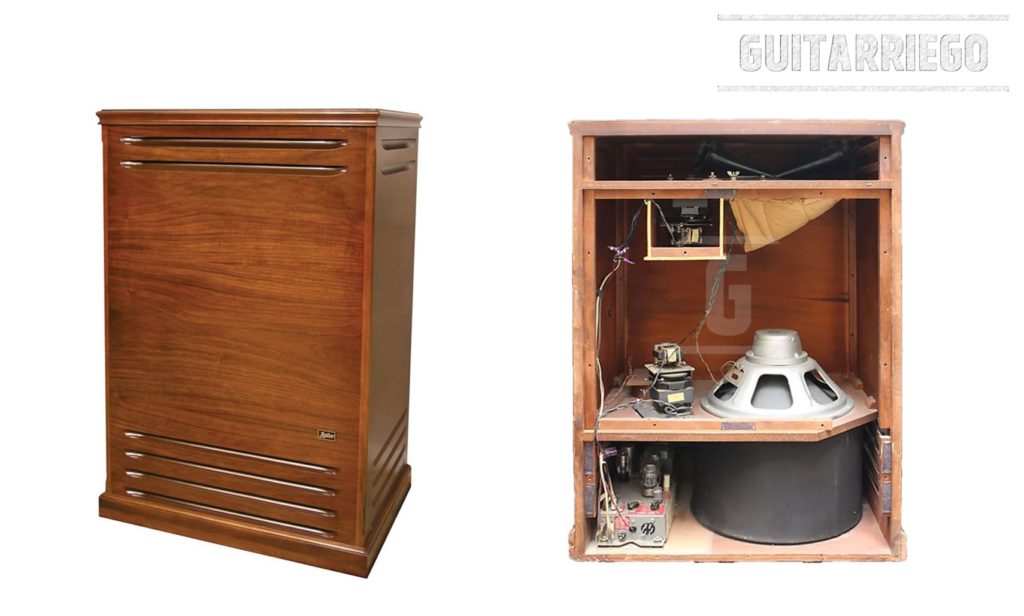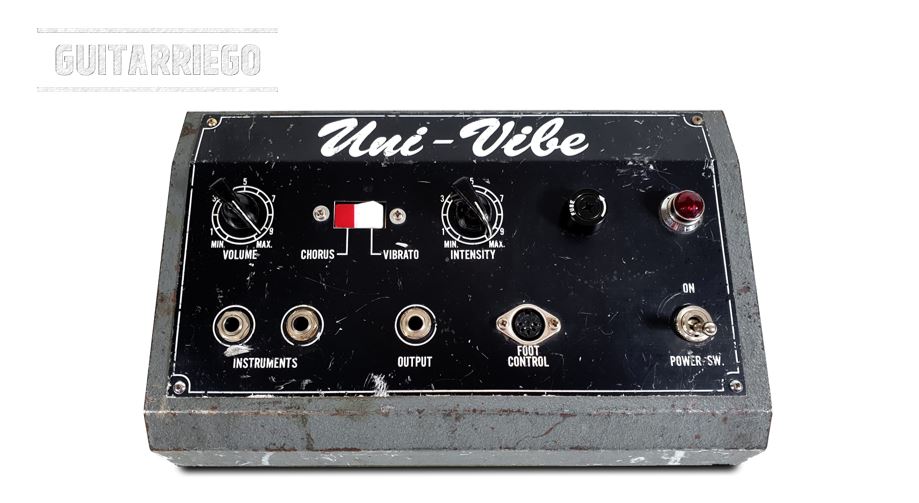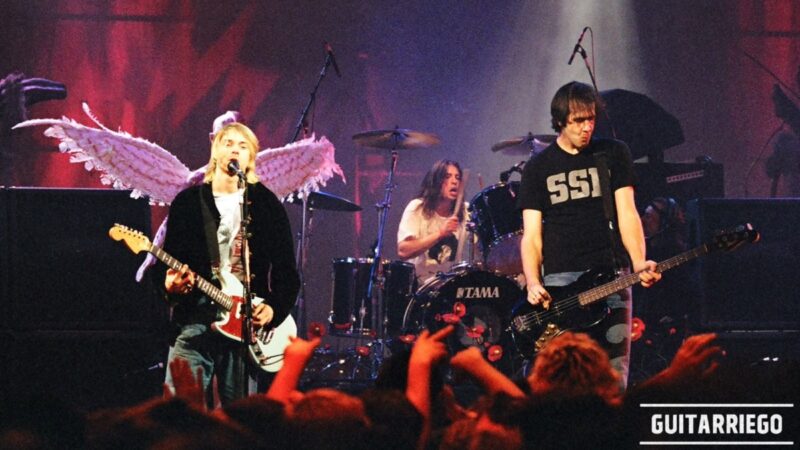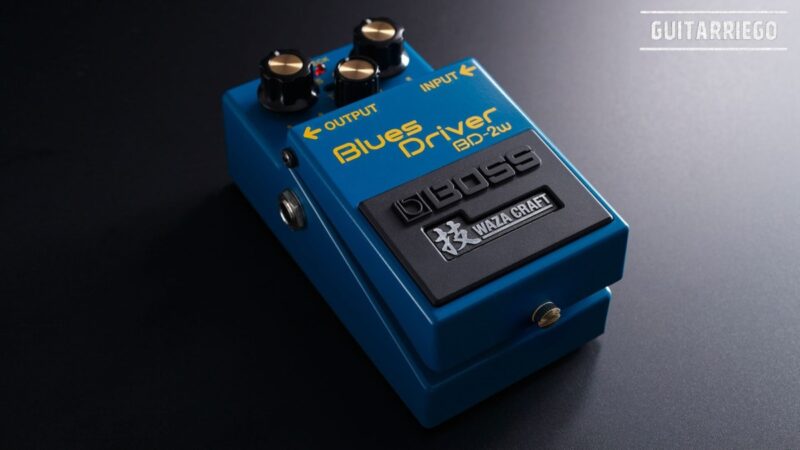Uni-Vibe: a classic guitar effect pedal

The Uni-Vibe or Univibe by Univox is a classic and iconic guitar pedal, categorized as a Phaser Shifter that simulates the doppler effect generated by a Leslie speaker, immortalized by Jimi Hendrix.
Uni-vibe by Univox: sound characteristics of the guitar effect pedal
Its audio generates an oscillation that generates that surround sound of the guitar. It is a mix between a Phaser and a Tremolo, a combination of various effects or pedals that are used to emulate the sound of a rotary speaker like the Leslie.
Without a doubt, the Uni-Vibe or Univibe pedal by Univox is a very particular effect, a tango that could be classified as a category unto itself.
History and fame of the Uni-Vibe guitar pedal
This effect pedal was created in 1968, its aim was to emulate the effect of Leslie amps, used for Hammond organs. However, it was later popularized among guitarists and implemented for the electric guitar.

Leslie loudspeakers were highly sought after, but difficult to move because of size and weight, so Shin-ei, a Japanese company, designed and created the Univibe.
Its fame was due to its sound with a characteristic depth that no other Phaser can achieve. This characteristic and quality is a direct consequence of the novel and curious design of its circuit or scheme.
Thus, the Uni-Vibe is one of the most iconic guitar effects pedals in the history of music. Since the late 1960s, pioneering guitarists have used it to expand the tonal and textural palette of the electric guitar.
Univibe: adoption by guitarists
Great guitarists used the effect and used it to record immortalizing their audio in our ears and heads forever. The most recognized and famous case is that of Jimi Hendrix, becoming a classic of effects pedals.

Univox Univibe Operation and Controls
The original pedal design has two knobs or knobs that control the master volume, which handles the overall volume of the effect, and the intensity, which defines the depth level of the effect’s oscillator. However, one of the singularities or characteristics is that the speed control of the oscillator is operated by a volume pedal, similar to that of a wah-wah, so that this speed can also be varied while playing the guitar, producing an oscillation. so characteristic and unique.
In addition, the pedal has a switch that allows you to choose between chorus or vibrato mode. The first mode, chorus, allows you to obtain a mix or blend between the original signal or dry signal of the guitar and the signal processed by the four stages of phasing shifted of the effect. In contrast, the vibrato mode works only with 100% of the signal processed by the effect. Thus, the vibrato mode gives the feeling of more depth of the effect and becomes more present.
Thus, these modes are really nothing more than two ways of mixing or blending the signals already preset by default or factory. Both functions are highly musical and offer different characteristics, making it a very practical control to obtain different nuances in our sound.

Uni-Vibe Pedal Circuit Layout or Schematic
On a technical level, the UniVibe circuit or scheme is really original, and curious. It employs some tricks that are what give it that characteristic audio.
Low Frequency Oscillator (LFO)
The heart of the effect is the low frequency oscillator (LFO) that moves the lamp or bulb. This is one of those responsible for that uniqueness. The inventory of the circuit, Fumio Mieda, his initial idea was different but, to achieve a greater dynamic range in the effect, he decided to use a bulb coupled to four photoresistors, which coincide with the four stages of phasing. Due to the problems he encountered in getting light bulbs with the adequate response to his needs, he had to develop his own oscillator, based only on resistors, capacitors and transistors. In his own words, “this was not a method that engineers usually used, but I wanted to try as I liked to try new things.”
“This was not a method that engineers usually used, but I wanted to try as I liked to try new things.”
Fumio Fear
Thus, this uniqueness of the circuit is what has meant that very few clones of the Uni-Vibe come to offer or come close to the quality and almost unique sound of the original model.
Another of the curiosities of the original model is that it is not True Bypass. In fact, it doesn’t even have a footswitch. It only has a hand token that activates or turns off the current, that is, it turns it on or off.
Unlike other effect pedals that also do not have True Bypass, the original Uni-Vibe pedal does not cause a loss of tone in our signal chain. However, what it does do is slightly decrease the volume of the guitar.
Uni-Vibe Pedal: Extremely Expensive Collectibles
Getting a genuine Uni-Vibe guitar pedal from Univox is tricky and really expensive. An original, if you manage to get its price, can be around USD 3,000. For all those guitarists who cannot get one, luckily there are some clones or the like.

Uni-Vibe clones
Due to the fame that the original Uni-Vibe achieved, and like any classic pedal, a multitude of manufacturers or manufacturers of guitar effect pedals have emerged, who have developed circuits trying to simulate the sound of the original.
Josh Scott, from JHS explains quite well and clearly the operation of the Univibe in the following video in which he also shows other pedals that emulate it.
The Uni-Vibe is not a Chorus, it is not a Phaser, it is a Uni-Vibe!
Josh Scott from JHS
Some of the manufacturers claim to have copied and cloned the schematics and designs from the original Univibe circuit. On the other hand, other pedal builders try to get closer to the desired sound by trying to emulate the dynamics and surround effect that the Leslies speakers gave, since it is believed that the sound that the Uni-Vibe was trying to achieve was exactly that, making similar circuits. but own and original.
MXR Uni-Vibe Chorus / Vibrato
The MXR Dunlop Uni-Vibe Chorus / Vibrato features a simple three-button interface for setting up the iconic effect. The Level or Volume, Speed -speed- and Depth -depth. In addition, it has the Vibe control to select the chorus and vibrato mode.
This pedal is True bypass and costs USD 129.90 in large online stores.
JHS Unicorn
The famous boutique manufacturer JHS has their version of the Uni-Vibe, the Unicorn guitar effect pedal. It has volume, ratio, speed and depth controls and a Wet and Dry switch, the wet is the Vibrato mode and the dry is the Chorus.
This pedal costs USD 169.90 in large online stores.
Fulltone Deja Vibe
This is a discontinued pedal, but Mike Fuller, owner of Fulltone, claimed to have achieved total fidelity to the sound of the original is Mike Fuller, from Fulltone. On his website, he explained that he had his photoresistors and bulbs built from the specifications he extracted from the interior of four original Univibe. Mojo or reality? Once again, we leave the choice to the ears of the readers.
DIYer clones of the UniVibe
An alternative to buying an extremely expensive original, or one of the copies on the market, is to DIY a clone.
This type of project is widely documented on the internet and DIYer websites. A reference in terms of information on this model is the website of the guru of analog effects R. G. Keen, Geofx, here is the page with the diagram or design of the Uni-Vibe circuit. There, the circuit analysis is detailed as well as a project with all the information necessary to build a clone of the effect pedal.
Unavailability of Genuine Uni-Vibe Components
However, when it comes to making a DIY clone, we will find ourselves with the same problem that current manufacturers encounter: the lack of availability of the original parts. In electronics stores we can find spare parts with characteristics similar to those of the original parts, with which to get a sound very close to the one we are looking for. Of course it won’t sound the same, but it will be very close.
Uni-Vibe review
Without a doubt, it is one of the most unique and peculiar electric guitar effect pedals in rock, as well as the most classic and emblematic of Rock. Bring an expressiveness and psychedelic character to your guitar audio. It is not for everyone, but without a doubt, it is a pedal that generates passion and fanaticism. Have you tried it?
For more information, visit MXR web site.
Related Post: Best 12 tips and tricks to setup your pedalboard.
You can share opinions or also chat about this and more with other musicians in our comments section.






